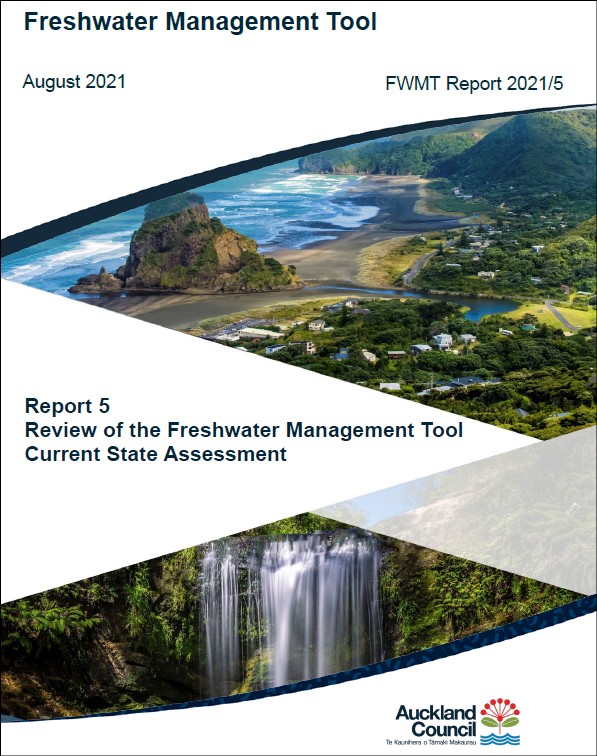Freshwater management tool: report 5. Review of freshwater management tool. Baseline state rivers
Author:
Auckland Council Healthy Waters Department, David P. Hamilton, Australian Rivers Institute, J. Christopher Rutherford, NIWA, Nic Conland, Taiao Natural Resource ManagementSource:
Auckland Council Healthy Waters DepartmentPublication date:
2021Topics:
EnvironmentFreshwater management tool: report 5. Review of the freshwater management tool. Baseline state assessment (rivers)
Report to Auckland Council by the Peer Review Team
Summary
Auckland Council is responsible for the development and implementation of plans and policies to improve the environment and reduce the risks of contamination of streams and other receiving waters (e.g., lakes, beaches, harbours) in the Auckland region. Monitoring is an important part of this responsibility and is used to report on the current state of the environment (SoE) and identify pressures affecting the current environmental condition. The SoE monitoring is expensive and captures only a subset of the regional stream network and the variations in stream flow and contamination concentrations, it is complemented with models that are designed to fill the gaps between monthly measurements and locations across the stream network. Importantly, a model that satisfactorily reproduces measured data can be used to inform plans and policies by testing current performance and generating future scenarios to predict what might occur using stream data generated by the model, with the input data adjusted to represent what is being tested. Such a model is also useful to test different environmental pressures (e.g., land use change, climate change).
Auckland Council has made a significant investment in a stream flow and contaminant model, known as the Freshwater Management Tool (FWMT), which includes a lake component. To understand the usefulness of the FWMT to inform plans and policies, the Council commissioned an external peer review of the four draft reports which document the modelling process. The draft reports include (1) data inputs to the FWMT, (2) the performance of the FWMT to assess its suitability for scenario generation, and FWMT simulations of the current state of (3) rivers and (4) lakes. This report presents the findings of the peer review team (PRT) that was composed of three experienced modellers familiar with the national and regional context for applications of models to inform plans and policies.
Stage 1 of the FWMT sought to satisfactorily simulate the current state of streams in the Auckland region based on six contaminants of concern: nitrogen (N) – total and dissolved forms, phosphorus (P) – total and dissolved forms, copper (Cu) and zinc (Zn) – total and dissolved forms, sediment – total suspended solids (TSS) and faecal indicator bacteria – E. coli. Other variables simulated by model were also used to assess its current state performance and included stream flow conditions, dissolved oxygen (DO) and pH. Future iterations of the model have the potential to simulate conditions for aquatic plants growth and decay cycles (large plants like macrophytes and microscopic plants like planktonic algae).
In the opinion of the PRT, the FWMT is a suitable framework for modelling the current state of flow and contaminant generation and delivery to streams at catchment scale but there are some aspects of the model that could be better aligned with input data representing the local conditions, biophysical processes and the management requirements of Auckland Council. Some predictions by the FWMT are classified as 'unsatisfactory' and should be the focus of the next application of the FWMT. The lake FWMT is not currently adequately developed to support scenarios at this stage and requires integration with the stream FWMT to properly quantify streamflow and nutrient loads to lakes.
The PRT identified a need to clearly define the way in which the FWMT is used to consider strategic regional planning for infrastructure, rural land use and operations, as well as mitigation activities that include changes in land use practices, wastewater treatment and green infrastructure enhancement. This 4
forward planning is essential to extend the value of the FWMT beyond the current state assessment but also means that consideration needs to be given to complementing the FWMT with other models specifically suited to the management and planning questions being asked.
The PRT also identified a need to improve the assessment and communication of the FWMT performance so that the model can be demonstrated to be a robust and reliable tool for comparing the relative performance of different planning and management scenarios. Following the identification of regional values and community goals, additional work on key processes in the model that affect DO and aquatic plants, informed by local observations and knowledge, are expected to improve the model fit to nutrient observations (nitrogen and phosphorus species). This development step will build confidence in the utility and forecasting capability of the model. In addition, some technical details of FWMT data reporting can be improved, including understanding what leads to uncertainty in the model output, including differences between the model output and the observations of variables.
The PRT supports the modelling strategy that Auckland Council has initiated in developing the FWMT for the planning of urban and rural development, good farm practices, assessment of life cycle costs and optimising investment in catchment mitigations/remediation. The PRT also supports the FWMT in assisting the Council to address the goals of the National Policy Statement for Freshwater Management to set and achieve objectives for water quality in freshwater management units in the region.
FWMT report 2021/5
Auckland Council, September 2022
*****
List of Freshwater Management Tool reports
2. Baseline configuration and performance | Report 2, appendices (in preparation)
3. Baseline state assessment (rivers) | Report 3, appendices (in preparation)
4. Current state assessment (lakes). Not published. Inquiries to: fwmt@aucklandcouncil.govt.nz
5. Review of the freshwater management tool. Baseline state assessment (rivers)
6. Literature review of primary sector responses to water quality: efficacy and cost
7. Riparian area management scenarios. Freshwater management tool
8. Lifecycle costs and benefits for rural mitigations in the freshwater management tool
11. Recommendations for improving rural mitigation modelling in the freshwater management tool
*****
Inquiries to: fwmt@aucklandcouncil.govt.nz
